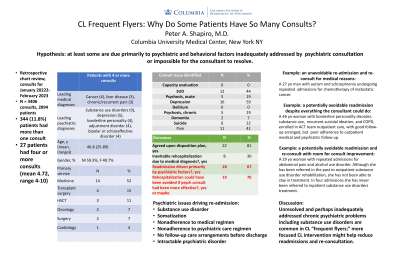Systems-Based Practice and Administrative Psychiatry
Session: Poster Session
(185) C-L "Frequent Flyers:" Why Do Some Patients Have So Many Consults?

Trainee Involvement: No
- PS
Peter A. Shapiro, MD, FACLP, DLFAPA (he/him/his)
Professor of Psychiatry, and Director, Consultation-Liaison Psychiatry Service
Columbia University Medical Center
New York, New York, United States
Presenting Author(s)
Background: Of the many patients seen by busy CL Psychiatry Services, a small number are “frequent flyers,” with many admissions and repeated psychiatric consultations. We hypothesized that while some of these repeated admissions and consultations are unavoidable by virtue of the patient’s medical conditions, some are due primarily to psychiatric and behavioral factors inadequately addressed by psychiatric consultations or impossible for the consultants to resolve.
Methods: retrospective review of NY Presbyterian Hospital Columbia University Medical Center CL Psychiatry Service case logs for January 2022-March 2023. We identified patients with more than one consultation. For purposes of this preliminary analysis, records of patients with 4 or more consultations in the 15-month period were reviewed for medical and psychiatric diagnoses. Psychiatric and medical diagnoses, clinical variables, and the presence or absence of an agreed-upon disposition plan were noted. The reviewer assessed whether readmission was driven by psychiatric factors and the possibility that readmission could have been avoided with more effective consultation intervention.
Results: There were 3427 consultation orders for 2850 unique patients; 346 patients (12.5%) had multiple consultations. 267 patients had two consultations, 54 patients had three, and 25 patients had > 3 separate consultations. In the group with four or more consultations (mean, 4.74; range, 4-10), the most common medical diagnoses were cancer (n=5, including leukemia and lymphoma), and chronic pain (n=4), and the most common psychiatric diagnoses were substance use disorders (n=10), borderline personality disorder (n=4), and bipolar or schizoaffective disorder (n=4). In only 6 of these 25 cases did the primary medical condition inevitably drive readmissions; in 17 cases, readmission was driven primarily by psychiatric and behavioral factors (eg, somatization, non-adherence, relapse); rehospitalizations might have been avoided in 21 of the 25 cases with more effective consultation interventions, especially referral to inpatient substance use disorder rehabilitation and helping the patient make a definite psychiatric follow-up plan including a specific follow-up appointment.
Discussion: Unresolved and perhaps inadequately addressed chronic psychiatric problems including substance use disorders are common in CL “frequent flyers;” more focused CL intervention might help reduce readmissions and re-consultation.

